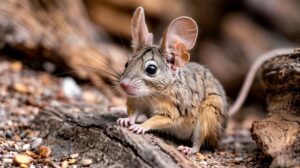Table of Contents
What Exactly IS a Jerboa?
Built for the Desert: Adaptations of a Leaping Legend
Legs for Days
Water-Wise Wonders
Jerboas in Peril: Conservation Concerns
Fun Facts About Jerboas
Frequently Asked Questions (FAQ)
What Exactly IS a Jerboa?
Jerboas are nocturnal rodents belonging to the family Dipodidae. Found primarily in the deserts of North Africa and Asia, these creatures are easily recognizable by their disproportionately long hind legs, short forelimbs, and long tails, often ending in a tuft of fur. Imagine a mouse crossed with a kangaroo, and you’re getting close! There are over 30 different species of jerboa, each uniquely adapted to its specific desert environment. They range in size, but most are no bigger than your hand – making them ridiculously cute, if I do say so myself.

Built for the Desert: Adaptations of a Leaping Legend
The desert is a harsh environment, but jerboas have evolved some incredible adaptations to thrive in it. These adaptations are not just about survival; they’re about mastering the desert landscape.
Legs for Days (and Hops!)
Let’s talk about those legs! Jerboas have incredibly long hind legs, perfect for hopping. Their hopping gait isn’t just for show; it’s an incredibly efficient way to move across the sand. They can reach speeds of up to 15 miles per hour when escaping predators. Think of them as tiny, furry rockets! The long tail acts as a counterbalance, helping them maintain their balance during those impressive leaps. It’s like having a built-in stabilizer bar!
Water-Wise Wonders
Water is scarce in the desert, so jerboas have developed ingenious ways to conserve it. They primarily obtain water from the food they eat, such as seeds, roots, and insects. Their kidneys are also incredibly efficient at concentrating urine, minimizing water loss. They’re practically living water conservation experts! Some species even plug the entrance to their burrows during the day to reduce moisture loss. Talk about clever!
Jerboas in Peril: Conservation Concerns
Unfortunately, like many desert animals, jerboas face a number of threats. Habitat loss due to agriculture and urbanization is a major concern. Climate change, with its increased temperatures and unpredictable rainfall, also poses a significant challenge. Some species are also hunted for food or traditional medicine. Conservation efforts are crucial to ensure these amazing creatures continue to thrive in their desert homes. Supporting organizations dedicated to desert conservation can make a real difference.
Fun Facts About Jerboas
* Jerboas can jump up to a meter high!
* They are primarily nocturnal, avoiding the scorching daytime heat.
* Some species have incredibly long ears, helping them to detect predators.
* Jerboas build complex burrow systems to escape the heat and predators.
* They are known to plug their burrows with sand to maintain humidity.
Frequently Asked Questions (FAQ)
Q: Are jerboas good pets?
A: While they might seem cute and cuddly, jerboas are wild animals and are generally not suitable as pets. They have very specific needs that are difficult to meet in a domestic setting.
Q: What do jerboas eat?
A: Jerboas are omnivores, but their diet mainly consists of seeds, roots, insects, and occasionally small invertebrates.
Q: Where do jerboas live?
A: Jerboas are found primarily in the deserts of North Africa and Asia.
Q: Are jerboas endangered?
A: The conservation status varies depending on the species. Some species are relatively common, while others are considered vulnerable or endangered.
Q: How long do jerboas live?
A: In the wild, jerboas typically live for 2-4 years. In captivity, they may live longer, but again, it is not recommended to keep them as pets.
